How To Shop For A Used PWC
Smart shopping tips for finding a quality pre-owned craft
I’m all for the latest and greatest PWC on the market. They’re powerful, clean, and quiet, and boast features that truly make riding safer and more enjoyable. The harsh truth, however, is that not everyone can afford – or even wants – to part with the thousands and thousands of dollars it takes to secure one, or be saddled with a loan for years to come. Throw in the economic climate of the last several years, and it’s easy to see why the sales of used (sorry, make that pre-owned) personal watercraft have skyrocketed.
Previously owned craft, however, come with a stigma. Someone else has used, maybe even abused them. Chances are you’ll know little of the craft’s history, meaning your purchase could truly be the deal you’ve been waiting for, or the beginning of a nightmare.
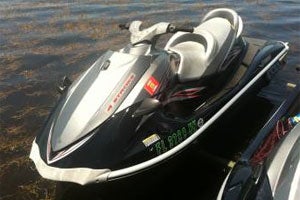 A popular model, like this Yamaha VX, is easier to find parts for.
A popular model, like this Yamaha VX, is easier to find parts for.How to tilt the odds as far as possible in your favor? Start by doing the same thing you should do when buying a new PWC. Do a little research, decide what type of craft best fits your riding style and goals, be realistic about your budget, and focus your search accordingly. If you’re looking for thrills, ignore that great deal on the entry-level three-up. It’s not the boat for you. On the flip side, if you’re looking for something to satisfy the family and stretch your fuel budget, don’t get tempted by that supercharged screamer.
In general, craft with a long track record are best. If they’ve been a perennial favorite over the years, chances are you’ll have an easier time finding parts.
Other precautions before you get in too deep? Unless you’re a skilled mechanic, avoid a “project” boat. You may get one heck of a deal, but you’ll spend a lot of time and money getting it back up to speed, and may get in over your head. If you end up having to hire a mechanic or take the boat to the dealer to finish what you started, that deal will be anything but.
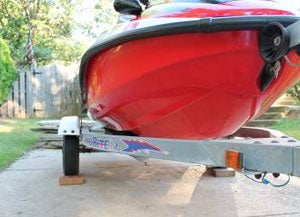 Check the entire craft over for damage. Pay particular attention to the hull and look for signs of stress cracks.
Check the entire craft over for damage. Pay particular attention to the hull and look for signs of stress cracks.Where to search? In today’s digital world, the Internet is the obvious choice. You can find a search tool for used boats right here on PersonalWatercraft.com. Other sources include Craigslist, eBay, BoatTrader.com, the numerous PWC-oriented forums available, local classifieds, local PWC and boat dealers, even keeping your eyes open for a For Sale sign when driving around the neighborhood. Know of a favorite local riding area? Stop by, make a few friends, and ask if anyone knows of anything for sale. Explore all options, and broaden your list of potential candidates.
In truth, that may be the easy part. It’s once you find a craft you’re interested in that things can get tricky.
Start with a thorough inspection from bow to stern of the craft’s exterior. Does the craft look like it’s been well maintained over its entire life, or just cleaned up for the sale? Anything from the condition of the paint and decals, to scratches and gouges in the hull and deck, to rips or wear in seat covers, grips, or traction mats can provide clues. Look at the hull for signs of stress cracks or damage, particularly around the bond line and engine bulkheads. Superficial damage can be overlooked, but anything structural will need repair…and make you wonder just how it happened and what else might be affected.
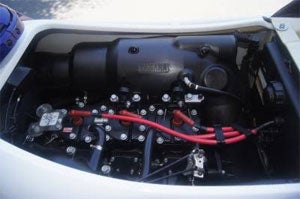 Take a good long look in the engine compartment. A clean engine is a good sign that the craft has been taken care of.
Take a good long look in the engine compartment. A clean engine is a good sign that the craft has been taken care of.Sometimes it’s easier to find answers in the engine compartment. Anyone can clean up a bilge, but look in nooks and crannies to see if the care has been long term or just a recent once-over to wipe away the most obvious gunk. Look closely at the engine’s exterior. Metal rusts, so check out parts that sit lower in the engine compartment, like motor mounts, to make sure they’re in good condition. Ask to see underneath the craft, and shine a flashlight up into the pump area to inspect the impeller’s condition. Blades should be clean and sharp, and the leading edges free of the nicks that are the result of sucking up rocks and debris in shallow water. The clearance between the impeller and the pump liner should be minimal, but without contact. Excessive clearance will hurt performance and only be remedied with a new impeller.
While a visual inspection is key, it’s the engine’s internal condition that is most important. Obviously unless you’re a mechanic, that’s hard to determine. It’s a given that you should take the craft for a test ride. Pay attention to everything, including how easily the motor starts, whether the starter cleanly engages or whirs or clunks, whether the engine seems to purr smoothly or instead runs rough, what sounds come from the driveline, etc, etc, etc. Run if the seller says the boat “just needs a tune-up.” It should have already been done. Listen to the boat and make a judgment about whether it’s running smoothly, or seems to have some issues that may come back to haunt you someday.
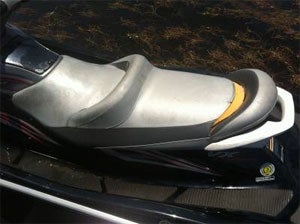 A worn out seat cover may indicate the owner wasn’t overly concerned with caring for the craft.
A worn out seat cover may indicate the owner wasn’t overly concerned with caring for the craft.Don’t be shy about asking to inspect things as closely as possible. Look carefully for any residue around individual engine parts; it could be a sign of a blown gasket. Signs of oil could indicate problems with the crankshaft seal. Chalky looking buildup often points to a leak in the cooling system, and carbon-like residue may point to an exhaust leak.
While you’re in inspection mode, don’t forget other areas, like steering and throttle cables. Handlebars should move freely and the throttle should respond crisply. If there is any feeling of roughness or binding, take note. At the least it’s a likely cable replacement, at the worst it could be a safety issue.
If it’s impossible to test ride the craft, and you really think this may be the deal you’re looking for, at least demand it be hooked up to a flush hose, started, and run for several minutes. You won’t be able to judge the engine’s worthiness under a real load, but you can at least verify if it starts and idles smoothly. You can also check compression with a compression gauge. Look up the stock compression of the particular model on the Internet, and make sure cylinder readings don’t differ by any more than 5%.
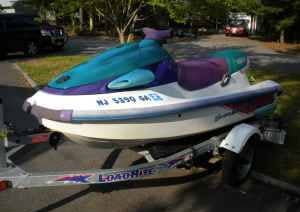 Taking the craft out on the water for a test ride should be a top priority before handing over your money.
Taking the craft out on the water for a test ride should be a top priority before handing over your money.Better yet, ask the seller whether they’d be willing to let you have it inspected at a local shop, or allow you to bring a mechanic to the seller’s location. Chances are you’ll have to foot the bill, but the dollars you spend here could save you many more in the long run. This is even more important for modern four-strokes, as they are just technically far more complex than previous two-stroke engines.
Convinced this is the deal you’ve been waiting for? Look up what the craft is worth at nadaguides.com, and try to find what similar models have been selling for in your area. Adjust your offer to take into account the boat’s condition, and any repairs you’ll have to make. When the deal is agreed upon, have the seller provide a bill of sale, with hull ID# (make sure it matches the boat!) and price, as well as sign over the craft’s title, hand over the cash or check, and head to the DMV to register your new prized possession.
Related Reading
Five Steps to Finding the Perfect PWC
How To Make The Most Of A PWC Demo Ride
How To Find Good Service For Your PWC
Get PersonalWatercraft.com in your Inbox!
Like PersonalWatercraft.com on Facebook
Comments
Most Popular

2025 Yamaha JetBlaster PRO 2-Up Review

2024 Kawasaki Jet Ski STX 160X Review

Remembering the Sea-Doo XP

Whatever Happened to the Wetbike?

2025 Yamaha JetBlaster Review





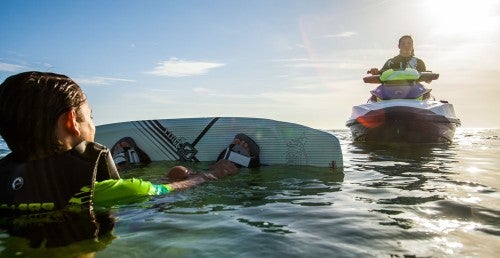






 Your Privacy Choices
Your Privacy Choices